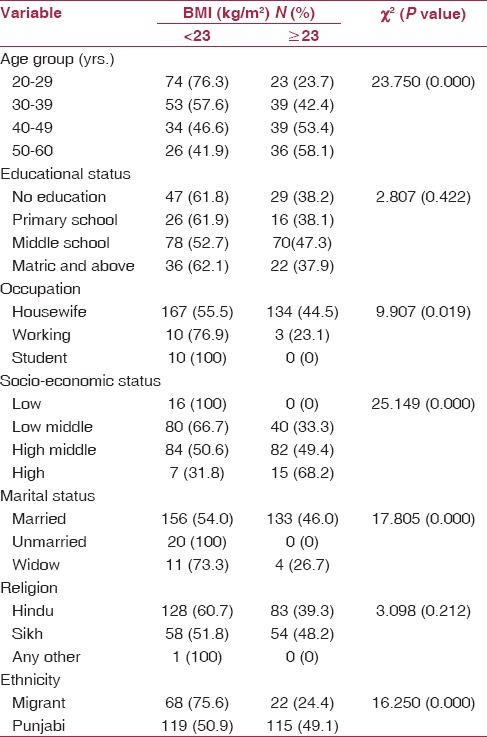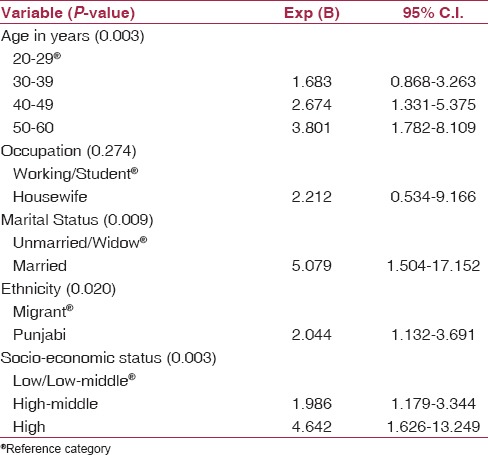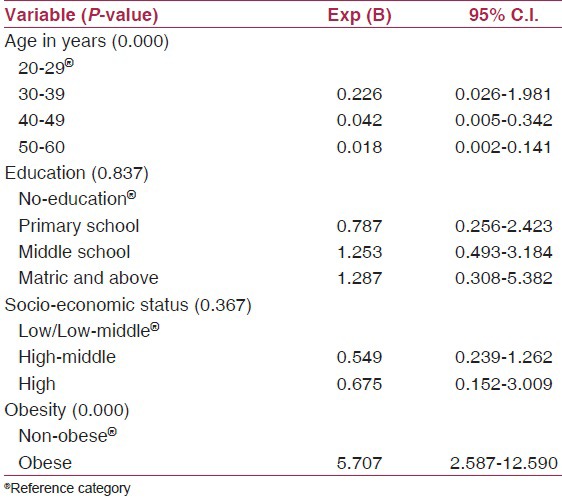Abstract
Background:
Obesity is a complex, multi-factorial chronic disease. Overweight and obesity are the fifth leading risk for global deaths.
Objectives:
To find the prevalence and risk factors for obesity in women aged 20-60 years in Ludhiana city.
Methods:
The present study is a community based cross sectional study carried out in an urban area of Ludhiana among women aged 20-60 years. Among the study population of 324 women, a pre-designed and pre-tested questionnaire was used to record the socio-demographic and anthropometric profile of women. Chi square test and logistic regression was used to find the association of obesity and hypertension with socio-demographic variables.
Results:
The prevalence of overweight and obesity was 12.7% and 29.6% respectively. Obesity was found to be more common among middle-aged Punjabi housewives belonging to upper socio-economic strata. There was strong association between overweight/obesity and hypertension.
Keywords: Obesity, overweight, BMI, marital status, hypertension
Introduction
Obesity is a complex condition, one with serious social and psychological dimensions, that affects virtually all age and socio-economic groups and threatens to overwhelm both developed and developing countries.(1) As in developed societies, the risk for obesity in developing countries is also strongly influenced by diet and lifestyle, which are changing dramatically as a result of the economic and nutrition transition. Obesity is a key risk factor in the natural history of non-communicable diseases like hypertension.
According to WHO global estimates, about 13% of the world's adult population (11% of men and 15% of women) were obese in 2014.(2) Prevalence of obesity varies according to age, sex and region. In India the percentage of ever married women aged 15-49 years who are overweight or obese increased from 11% in National Family Health Survey (NFHS)-2 to 15% in NFHS-3.(3) The percentage of women who are overweight or obese is highest in Punjab (29.9%), followed by Kerala (28.1%) and Delhi (26.4%).(4) Therefore in the present study, an attempt has been made to find the prevalence and risk factors for overweight and obesity in women aged 20-60 years in Ludhiana city.
Materials and Methods
The present study is a cross sectional, community based study carried out in an urban area of Ludhiana among women aged 20-60 years during 2013. The sample size of 324 was calculated on the basis of 30% prevalence rate of obesity among women in Punjab according to NFHS-3 data, using formula in infinite population:(5)
Sample size (n) = z2 p (1-p)/d2
A list of all 3194 females between 20-60 yrs of age residing in the urban field practice area was made and the study subjects were selected by random sampling method. Antenatal women were excluded from the study.
A pre-designed, pre-tested questionnaire was used to record the socio-demographic profile of women after obtaining informed consent. Socio-economic status was determined by using Modified Kuppuswami scale.(6) Anthropometric data regarding height and weight was also taken. The body mass index (BMI) was calculated using Quetelet index. Asian classification of obesity(7) was used [Table 1]. The BP was recorded as per AHA guidelines.(8) Analysis was done in Microsoft excel and SPSS version 20.0. Chi square test was used to find the association between socio-demographic variables and obesity. Logistic regression analysis for dependent variables obesity and hypertension was done. The independent variables considered for this analysis were age, occupation, marital status, ethnicity and socio-economic status for dependent variable obesity, and age, education, socio economic status and obesity for dependent variable hypertension. P < 0.05 was taken as significant.
Table 1.
WHO Asian-BMI classification

Results
In the study population, the prevalence of overweight (BMI = 23-24.9) and obesity (BMI > 25) was 12.7% and 29.6% respectively. Most of the overweight/obese women belonged to the age group of 40-60 years and prevalence increased with increase in age (P < 0.001). On univariate analysis, obesity was found to be significantly more in married Punjabi housewives of upper socio-economic strata [Table 2]. The effect of selected variables of obesity and hypertension was analysed by performing logistic regression analysis. Increasing age, native Punjabi origin and upper socio-economic strata were found to be independent risk factors for obesity [Table 3]. In conducting binary logistic regression for hypertension, age and obesity were highly significant predictors for development of hypertension [Table 4].
Table 2.
Association of BMI with various socio-demographic variables of study subjects

Table 3.
Logistic regression analysis with dependent variable obesity

Table 4.
Logistic regression analysis with dependent variable hypertension

Discussion
The study was carried out in an urban area of Ludhiana to find out the prevalence of overweight and obesity among women aged 20-60 years which was found to be 12.7% and 29.6% respectively. This is comparable with the findings of NFHS-3 where prevalence of overweight/obesity in females was found to be 29.9%.(4) In a study conducted by Anuradha et al. in women aged 20 yrs and above in Chennai,(9) the prevalence of overweight and obesity was 27.7% and 19.8% respectively whereas in another study conducted in upper middle class urban women aged 20 yrs and above in Punjab, the prevalence was 20% and 25.3% respectively.(10)
The prevalence of overweight/obesity was highest in the age group of 50-60 years followed by 40-49 years and the trend was found to be statistically highly significant. Misra et al.(11) also found a significantly increasing trend with advancing.
In the present study, prevalence of obesity was highest in housewives belonging to higher socio-economic status. Similar trend was reported by Gopalan(12) in 1998 and Anuradha et al.(9) in 2009. Obesity was also found to be significantly higher in married and Punjabi women in the present study. The higher prevalence among Punjabi housewives in the age group of 40-60 years could be due to menopausal changes, decreasing physical activity and high fat diet.
Obesity was seen more frequently in literate women (43.5%) as compared to illiterate (38.2%) but the difference was not significant. Similar findings were seen in the study conducted by Anuradha et al.(9) On logistic regression, obesity was significantly more in middle aged, Punjabi housewives belonging to upper socio-economic class. Highly significant number of middle aged obese women were found to be hypertensive as compared to non obese females. In a study conducted in Africa,(13) BMI was positively associated with systolic, diastolic and mean arterial pressure. Gothankar(14) also found a significant association between BMI and hypertension in her study conducted in Pune.
Conclusion and Recommendation
In the present study, obesity was highest in middle aged housewives belonging to middle and high socio-economic status. Hypertension was more common in obese women therefore specific programs targeting high risk and vulnerable group of the society need to be designed to address this upcoming epidemic.
Footnotes
Source of Support: Nil
Conflicts of Interest: None declared.
References
- 1.Controlling the global obesity epidemic. World Health Organization. [Last accessed on 2015 Apr 25]. Available from: www.who.int/nutrition/topics/obesity/en/
- 2.Obesity and Overweight. World Health Organization. [Last accessed on 2015 Apr 25]. Available from: http://www.who.int/mediacentre/factsheets/fs311/en/
- 3.Nutrition in India. National Family Health Survey (NFHS-3) India 2005-06. International Institute for Population Sciences Deonar, Mumbai. [Last accessed on 2014 Apr 28]. Available from: http://www.rchiips.org/nfhs/nutrition_report_for_website_18sep09.Pdf .
- 4.National Family Health Survey-3, India, 2005-2006 Adult Nutrition. [Last accessed on 2014 May 01]. Available from: http://www.nfhsindia.org/NFHS/NFHS-3%20 Nutrional%20Status%20of%20Adultsppt .
- 5.Lemeshow S, Hosmer DW, Klar J, Lwanga SK. World Health Organization. Adequacy of Sample Size in Health Studies. John Wiley & Sons Publications. 1990:42. [Google Scholar]
- 6.Bairwa M, Rajput M, Sachdeva S. Modified Kuppuswamy's Socioeconomic scale: Social researcher should include updated income criteria, 2012. Indian J Community Med. 2013;38:185–6. doi: 10.4103/0970-0218.116358. [DOI] [PMC free article] [PubMed] [Google Scholar]
- 7.Geneva: World Health Organization; 2000. World Health Organization (WHO). International Association for the Study of Obesity (IASO) and International Obesity Task Force (IOTF). The Asia-Pacific Perspective: Redefining Obesity and its Treatment; pp. 378–420. [Google Scholar]
- 8.Smith L. New AHA recommendations for blood pressure measurement. Am Fam Physician. 2005;72:1391–8. [Google Scholar]
- 9.Anuradha R, Ravivarman G, Jain T. The prevalence of overweight and obesity among women in an urban slum of Chennai. J Clin Diagn Res. 2011;5:957–60. [Google Scholar]
- 10.Sidhu S, Tatla HK. Prevalence of overweight and obesity among adults urban females of Punjab: A cross-sectional study. Anthropologist. 2002;4:101–3. [Google Scholar]
- 11.Misra A, Pandey RM, Devi JR, Sharma R, Vikram NK, Khanna N. High prevalence of diabetes, obesity and dyslipidaemia in an urban slum population in northern India. Int J Obes Relat Metab Disord. 2001;25:1722–9. doi: 10.1038/sj.ijo.0801748. [DOI] [PubMed] [Google Scholar]
- 12.Gopalan C. Obesity in the urban ‘Middle Class’. NFI Bull. 1998;19:1–8. [Google Scholar]
- 13.Mufunda J, Mebrahtu G, Usman A, Nyarango P, Kosia A, Ghebrat Y, et al. The prevalence of hypertension and its relationship with obesity: Results from a national blood pressure survey in Eritrea. J Hum Hypertens. 2006;20:59–65. doi: 10.1038/sj.jhh.1001924. [DOI] [PubMed] [Google Scholar]
- 14.Gothankar JS. Prevalence of obesity and its associated comorbidities amongst adults. Natl J Community Med. 2011;2:221–4. [Google Scholar]


